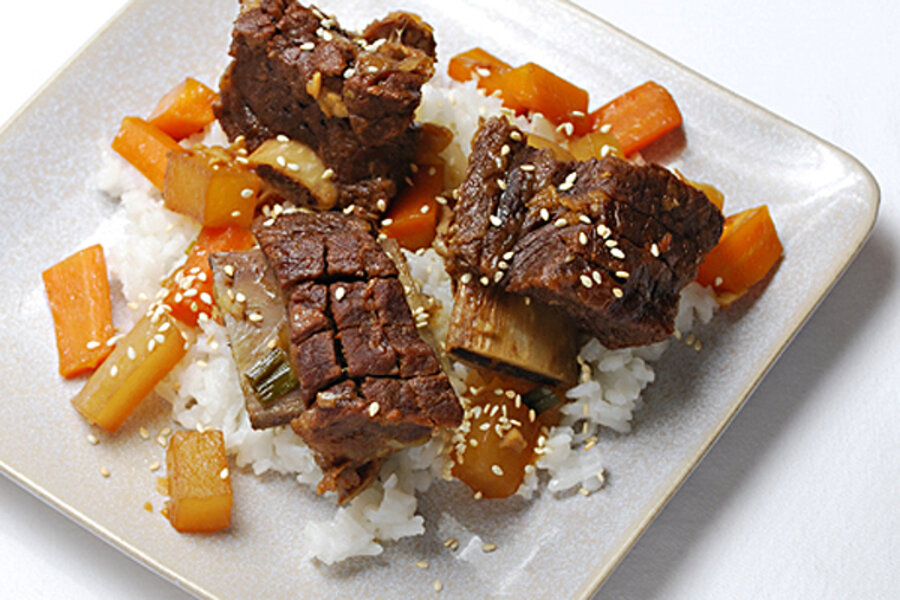Korean oven-braised short ribs
Loading...
One of the best things about exploring other countries’ cuisines is shopping. Saturday found us at H Mart in suburban Chicago, conveniently at lunchtime. We headed straight to the food court, where we ordered generous, steaming bowls of pork and kimchi dumpling soup. H Mart is an Asian-inspired supermarket chain that started in Queens, New York.
The name is short for “Han Ah Reum,” Korean for “One Arm Full of Groceries.” You’re lucky if you can get out of this sprawling treasure trove of all things Asian carrying just one armful of groceries. The vast produce section has beautiful examples of all the usual suspects as well as things hard to find elsewhere – lotus root, enoki mushrooms, turmeric (not the powder, but the actual gnarly little rhizomes), tiny, speckled fresh quail eggs, and so on. The specific ingredient I’d gone in search of was Korean-style beef short ribs. We left, of course, with our arms more than full.
Korean-style short ribs actually come in a few different cuts. One is also known as the flanken cut, in which the ribs are sliced thinly across the bone, with three or more bones in each slice. What I was looking for were more like the standard short ribs you see in the supermarket, only shorter – they’re cut into two-inch (or so) sections. H Mart had both these cuts as well as others.
As winter seriously settles in, we’re looking for excuses to turn on the oven and fill the apartment with meaty cooking smells. There’s a dazzling array of variations on Galbi Jjim, traditional Korean braised short ribs, out there. One thing virtually all of them share is cooking them on the stovetop. I chose to oven braise them. Besides the reason stated above, oven braising wraps the whole pan in even, moderate heat instead of concentrating all of it on the bottom of the pan. However you cook them, the results are satisfyingly chewy/tender and delicious, flavorful but not spicy.
Korean braised short ribs (Galbi Jjim)
Serves 4
2-1/2 pounds Korean style short ribs
2 tablespoons canola oil
1 medium yellow onion, chopped
1 inch fresh ginger, peeled and minced
6 garlic cloves, minced
1/2 Asian or Bosc pear, peeled and grated on box grater
3/4-cup reduced-sodium soy sauce
1/2 cup dry white wine (may substitute cooking wine)
2 cups water
4 teaspoons sesame oil
2 teaspoons sugar
freshly ground black pepper
3 carrots, peeled and sliced into a large dice
1/2 pound piece of daikon (Japanese radish), peeled and cut into large dice (see Kitchen Notes)
1/2 cup chopped scallions
salt
1 tablespoon white sesame seeds, toasted (see Kitchen Notes)
cooked white rice
special equipment: parchment paper
Preheat oven to 350 degrees F. Score ribs on the meaty side with 1/2-inch slices across the grain; this will allow the meat to absorb more flavor from the braising liquid. Put short ribs in a large pot and cover with lots of cold water. Bring to a boil and simmer for 10 to 15 minutes. You can spoon off the scum that forms or not – you’re going to discard this water anyway. Remove the ribs with tongs and rinse under cold running water. This step gets rid of some of the blood and excess fat.
While the meat is simmering, combine ginger, garlic, pear, soy sauce, wine, water, sesame oil and sugar in a large bowl. Season with a generous grind of black pepper.
Heat the oil in a large Dutch oven over medium flame and sweat the onion until translucent and softening, three to five minutes. Add the braising liquid mixture to the Dutch oven and nestle the ribs, meaty side down, into the sauce. Bring to a boil and remove from heat. Press a piece of parchment paper cut to fit inside the Dutch oven down on top of the ribs. Cover the Dutch oven with lid and transfer to oven.
Braise ribs for 60 minutes. Remove from oven and add carrots, daikon and scallions, pressing down into the braising liquid. Replace the parchment paper and lid and return to oven. Braise for another 30 minutes.
Using tongs and a slotted spoon, transfer ribs and vegetables to a large bowl and tent with foil. Bring braising liquid to a boil over medium high flame and reduce slightly to a sauce, about five minutes.
Plate cooked rice in individual shallow bowls or rimmed plates. Top with ribs and vegetables and spoon sauce over. Sprinkle with toasted sesame seeds and serve.
Kitchen Notes
Daikon. In Japanese, daikon means “large root.” While you can find it in most Asian markets, the trick may be finding a non-giant piece. But find it if you can; it adds a tangy, sweet, crunchy bite to this dish. If not, some suggested substitutes include turnips, jicama, or water chestnuts. I can’t vouch for these, because I haven’t tried them.
Toasting sesame seeds. Crazy easy. Spread them in a single layer in a cold, dry nonstick skillet. Toast over medium heat, stirring frequently to avoid burning, until slightly golden and fragrant, three to five minutes.






